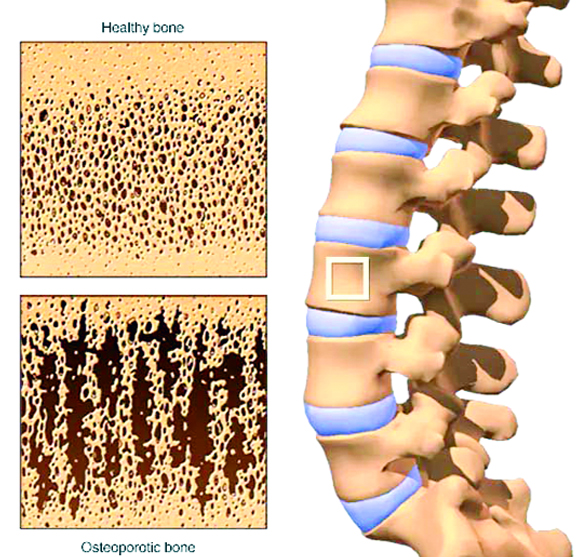Dr Akhil Kumar Gupta
Osteoporosis is a disease that weakens your bones. It makes your bones thinner and less dense than they should be. People with osteoporosis are much more likely to experience broken bones.
Your bones are usually dense and strong enough to support your weight and absorb most kinds of impacts. As you age, your bones naturally lose some of their density and their ability to regrow (remodel) themselves. If you have osteoporosis your bones are much more fragile than they should be, and are much weaker.
Most people don’t know they have osteoporosis until it causes them to break a bone. Osteoporosis can make any of your bones more likely to break, but the most commonly affected bones include your:
* Hips (hip fractures).
* Wrists.
* Spine (fractured vertebrae).
* Low back ache
* Cervical spondylosis
* Weakness and numbness in limbs
The sooner a healthcare provider diagnoses osteoporosis, the less likely you are to experience bone fractures. Ask a healthcare provider about checking your bone density, especially if you’re over 65, have had a bone fracture after age 50, or someone in your biological family has osteoporosis.
It might be hard to notice changes in your own physical appearance. A loved one may be more likely to see changes in your body (especially your height or posture). People sometimes joke about older adults “shrinking” as they age, but this can be a sign that you should visit a healthcare provider for a bone density test.
Overview
If you have osteoporosis your bones are much more fragile and weaker than they should be.
Symptoms and Causes
What are osteoporosis symptoms?
Osteoporosis doesn’t have symptoms the way lots of other health conditions do. That’s why healthcare providers sometimes call it a silent disease.
What causes osteoporosis?
Osteoporosis happens as you get older and your bones lose their ability to regrow and reform themselves.
Your bones are living tissue like any other part of your body. It might not seem like it, but they’re constantly replacing their own cells and tissue throughout your life. Up until about age 30, your body naturally builds more bone than you lose. After age 35, bone breakdown happens faster than your body can replace it, which causes a gradual loss of bone mass.
If you have osteoporosis, you lose bone mass at a greater rate. People in postmenopause lose bone mass even faster.
Osteoporosis risk factors
Anyone can develop osteoporosis. Some groups of people are more likely to experience it, including:
* Anyone over 50.
* People assigned female at birth (AFAB), especially people AFAB in postmenopause.
* People with a family history (if someone in your biological family has osteoporosis).
* People who are naturally thin or who have “smaller frames.” People with thinner statures often have less natural bone mass, so any losses can affect them more.
* People who smoke or use tobacco products.
Some health conditions can make you more likely to develop osteoporosis, including:
* Endocrine disorders – any condition that affects your parathyroid glands, thyroid gland and hormones (like thyroid disease and diabetes).
* Gastrointestinal diseases (like celiac disease and inflammatory bowel disease [IBD]).
* Autoimmune disorders that affect your bones (like rheumatoid arthritis or ankylosing spondylitis – arthritis that affects your spine).
* Blood disorders (or cancers that affect your blood like multiple myeloma).
Management and Treatment
How is osteoporosis treated?
Your healthcare provider will suggest a combination of treatments that slow down your bone loss and strengthen your existing bone tissue. The most important part of treating osteoporosis is preventing bone fractures.
The most common osteoporosis treatments include:
Exercise: Regular exercise can strengthen your bones (and all the tissue connected to them, like your muscles, tendons and ligaments). Your provider might suggest weight-bearing exercise to strengthen your muscles and train your balance. Exercises that make your body work against gravity like walking, yoga, Pilates and tai chi can improve your strength and balance without putting too much stress on your bones. You might need to work with a physical therapist to find exercises and movements that are right for you.
Vitamin and mineral supplements: You might need over-the-counter or prescription calcium or vitamin D supplements. Your provider will tell you which type you need, how often you should take them and which dosage you’ll need.
Adequate amount of exercise daily even in open playgrounds ,home,gyms.
* Milk and milk products daily.
* Fruits rich in vitamin c
* Yoga and meditation
* Proper sleep
* Good mental health and prosperous life
* Breast feed should be promoted in new borns
* Early mobilisation in case of sugery or suffering from lower back ache
* Habit of morning walk in sun exposed area in urban area
* Soya bean and protien rich diet
* Government should take initiative to promote physical education and sports in every institution.
* Quit bad habits , smoking , alcohol, Drugs , sedentry life style.
(The author is an Orthopaedic Surgeon)
Trending Now
E-Paper


